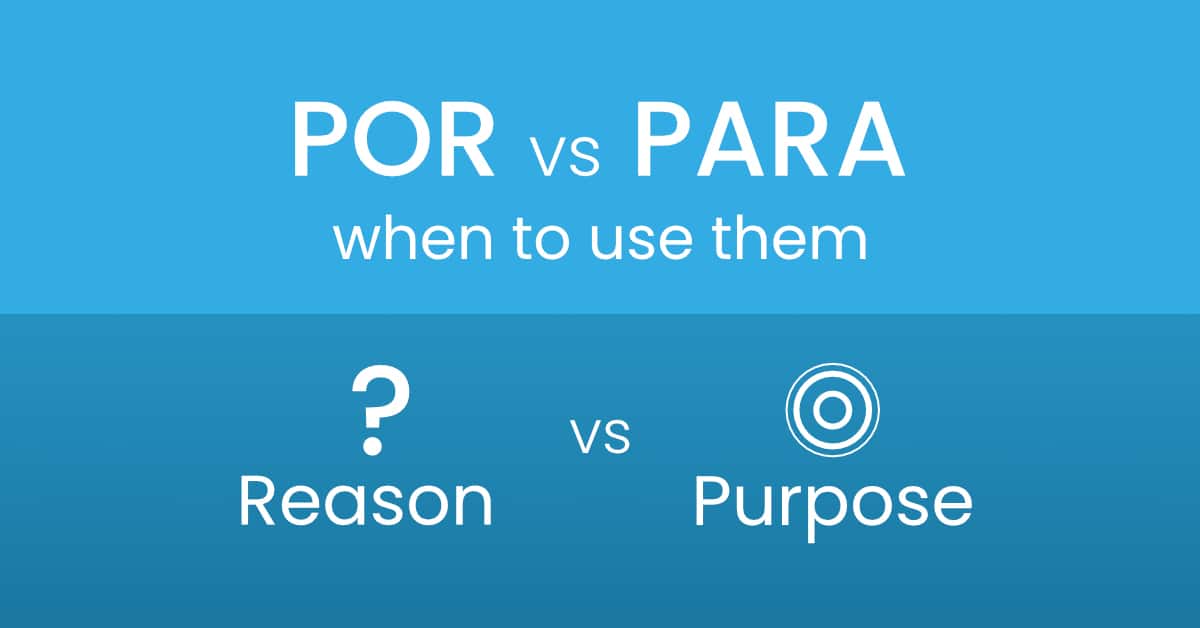Por and Para are two Spanish prepositions that can generate a lot of confusion for English speakers. You’ve probably heard that Por and Para both mean “for”, but, in reality, this is just one of the many meanings they have. However, we don’t intend to bombard you with all their meanings at once.
First, we’ll address the sources of confusion, and then we’ll go through the aspects that are easier to learn.
In most cases, Por and Para are used in Spanish when you use “for” in English. Accordingly, when you want to say “for” in Spanish, you have to decide whether to use Por or Para.
However, there’s no magical way to make the right choice, since it depends on what you want to say.
In other cases, Spanish speakers say Por and Para when we wouldn’t say “for” in English. Therefore, Por and Para don’t always mean “for”, and to learn them correctly, you have to understand their specific uses.
So, keep reading to learn more about Por and Para and when to use them in Spanish.
When is Para used as “for” in Spanish?
Para replaces “for” in English in the following contexts:
To Talk About Destinations
For example, when you would say “for” in English to refer to a destination, you use para in Spanish.
- El sofá es para la oficina.
(The sofa is for the office.) - La casa de Daniela es perfecta para la fiesta.
(Daniela’s house is perfect for the party.) - Me voy para la universidad a las 9 en punto.
(I leave for college at 9 o’clock.)
To Mention Recipients
In this example, the kids are receiving the gifts, so you use para in this sentence:
- Tengo regalos para los niños.
(I have gifts for the children)
To Talk About a Purpose, or the Use of Something
- Esta mochila es para viajar.
(This backpack is for traveling.)
To Talk About Deadlines
- Necesito dinero para el lunes.
(I need money for Monday) - Estará listo para el viernes.
(It will be ready for Friday)
When is para used for something other than “for”?
When Para Means “To”
In these examples, notice that España and la tienda are the destinations here, so this goes along with what we explained before.
- Voy para España. (which can also be Voy a España and still be a correct sentence)
I’m going to Spain. - Voy para la tienda. (also expressed as Voy a la tienda)
I’m going to the store.
When Para Refers to a Purpose, but you would Normally Address it with “In Order To”
- Comemos para vivir.
(We eat (in order) to live) - Estudio para pasar el examen.
(I study (in order) to pass the test)
When Para Stands for “By”, “On” or “Before”
- Necesito el dinero para el lunes. (Also phrased as Necesito el dinero antes del lunes)
(I need the money by Monday.)
When is Por used as “for” in Spanish?
Putting aside its meaning in context for a second, you can think of Por as a symbolic path or something that goes between two things, from start to finish. In this way, it’s simpler to understand the uses of Por.
When you Talk about Duration, you use Por in Spanish
- Estaré aquí por dos semanas.
(I’ll be here for two weeks) - Voy a la playa por el resto del día.
(I’m going to the beach for the rest of the day)
Another way to visualize por is as a scale, where the word structures placed before and after por have equal value or importance.
Therefore, when you are Talking about a Purchase, Trade, Exchange, or Substitution, you use Por in Spanish.
- Te daré $100 por el televisor.
(I will give you $100 for the TV) - Pagamos $20 por la cena.
(We paid $20 for dinner) - Daniel cambió su libro por una revista.
(Daniel traded his book for a magazine)
When you Talk about Emotions and Feelings, you use Por in Spanish
In this example, you could look at this sentence like mis padres are recipients, what they’re “receiving” is a feeling. So, it’s better to see this sentence as mis padres equals respeto, with por as a “scale”, with your parents on one side and respect on the other one.
- Tengo mucho respeto por mis padres.
(I have a lot of respect for my parents)
You can also see it on, where for someone, their nephews equal love.
- Tengo mucho amor por mis sobrinos.
(I have lots of love for my nephews).
When is por used for something other than “for”?
When you Mention Times of the Day
- Por la mañana. (Also said correctly En la mañana)
(In the morning.) - Por la tarde.
(In the afternoon.) - Por la noche.
(At night.) - Estudiamos por la mañana.
(We study in the morning.) - Trotamos por la noche.
(We jog at night.)
When Por Substitutes the English Word “Per”
In the example below, one week is seven days, so you can see again that por reflects equivalencies.
- Hay siete días por semana.
(There are seven days per week)
When you Want to Say the Means through which you Travel and Communicate
Examples:
- Viajo a Arizona por tierra.
(I travel to Amsterdam by land) - Voy a España por tren.
(I’m going to Spain via train) - Te escribo por email.
(I’m writing to you by email) - Te estoy hablando por teléfono.
(I’m talking to you on the phone)
When Talking about a Non-Final Destination
- Voy a Chile por Bolivia.
(I’m going to Chile via Bolivia)
When Por Stands for “Through”
- Ella camina por la tienda.
(She walks through the store)
Mixing up Por and Para in Spanish
In Spanish, por and para aren’t interchangeable. Thus, using either of these words changes the meaning of a sentence. For example:
- Voy a trabajar para mi amigo.
- Voy a trabajar por mi amigo.
I’m going to work for my friend.
The first sentence means that your friend is the recipient of your work, like a boss or a manager, while the second sentence implies that the reason that motivates you to work is your friend; this could be the case of being his substitute or helping him with his tasks.
You can associate para with the mental image of an arrow, which indicates aims, final destinations, deadlines, and recipients.
And associate por with a path or route that represents durations, reasons, dedicatories, and non-final destinations. For instance:
- Vamos para Argentina, por Brasil, por avión, por la mañana
(We’re going to Argentina, via Brazil, by airplane, in the morning)
Want to fully immerse yourself in Spanish? Take private Spanish lessons with one of our fluency coaches, our intuitive approach to conversational dynamics will help you get fluent faster than you think. Save 20% off your first month of lessons with code TF20 today!





